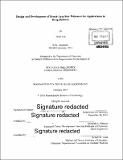| dc.contributor.advisor | Jeremiah A. Johnson. | en_US |
| dc.contributor.author | Liu, Jenny, Ph. D. Massachusetts Institute of Technology. Department of Chemistry | en_US |
| dc.contributor.other | Massachusetts Institute of Technology. Department of Chemistry. | en_US |
| dc.date.accessioned | 2017-06-06T19:24:53Z | |
| dc.date.available | 2017-06-06T19:24:53Z | |
| dc.date.copyright | 2016 | en_US |
| dc.date.issued | 2017 | en_US |
| dc.identifier.uri | http://hdl.handle.net/1721.1/109677 | |
| dc.description | Thesis: Ph. D. in Biological Chemistry, Massachusetts Institute of Technology, Department of Chemistry, February 2017. | en_US |
| dc.description | Pages 233-235 blank. Cataloged from PDF version of thesis. | en_US |
| dc.description | Includes bibliographical references. | en_US |
| dc.description.abstract | Treatment and prevention of disease is a major area of research effort and interest; development of new technologies could overcome limitations of current medicines, and provide new treatment modalities that improve patient outcomes. In cancer, small molecule chemotherapeutics often suffer from lack of selectivity, poor pharmacokinetics and biodistribution, limited solubility, fast clearance from the body, and development of resistance. Nano-sized particles that conjugate to or encapsulate small molecule drugs could address these issues by increasing circulation times and facilitating selective delivery of a higher drug load to the tumor, which overall can help improve efficacy and lower toxic side effects. This thesis describes the development of a unique polymer architecture - the Brush-Arm Star Polymer (BASP) - that represents a modular, customizable therapeutic platform with potential in drug delivery. In this thesis, BASPs are synthesized by ring opening metathesis polymerization (ROMP) of a norbornene functionalized PEG-based macromonomer to first form a living bottle-brush initiator. Next, a bifunctional norbornene crosslinker is added to the bottle-brush polymer to yield star polymers with a crosslinked-core and bottle-brush polymer arms. We synthesized a variety of functional macromonomers and crosslinkers to use in BASP synthesis. For example, drug-loaded doxorubicin macromonomers were synthesized that could release free doxorubicin under a light stimuli or by hydrolysis. Crosslinkers were designed to facilitate BASP degradation, and ultimately enable excretion of BASP components from the body. Various crosslinkers that respond to UV irradiation, change in pH, or reducing conditions were investigated. A multi-drug-conjugated BASP was synthesized and characterized that contained the drug components of FOLFIRINOX, a combination therapy regimen for pancreatic cancer. Nanoparticle combination therapy offers the advantage of delivering combination of drugs at desired ratios in one vehicle, which may improve efficacy due to drug synergism, enhance synthetic reproducibility, and reduce regulatory challenges. This thesis highlights the development of BASP nanotechnology in an effort to improve efficacy and reduce side effects compared to conventional therapeutics. | en_US |
| dc.description.statementofresponsibility | by Jenny Liu. | en_US |
| dc.format.extent | 235 pages | en_US |
| dc.language.iso | eng | en_US |
| dc.publisher | Massachusetts Institute of Technology | en_US |
| dc.rights | MIT theses are protected by copyright. They may be viewed, downloaded, or printed from this source but further reproduction or distribution in any format is prohibited without written permission. | en_US |
| dc.rights.uri | http://dspace.mit.edu/handle/1721.1/7582 | en_US |
| dc.subject | Chemistry. | en_US |
| dc.title | Design and development of Brush-Arm Star Polymers for applications in drug delivery | en_US |
| dc.title.alternative | Design and development of BASP for applications in drug delivery | en_US |
| dc.type | Thesis | en_US |
| dc.description.degree | Ph. D. in Biological Chemistry | en_US |
| dc.contributor.department | Massachusetts Institute of Technology. Department of Chemistry | |
| dc.identifier.oclc | 988610121 | en_US |
